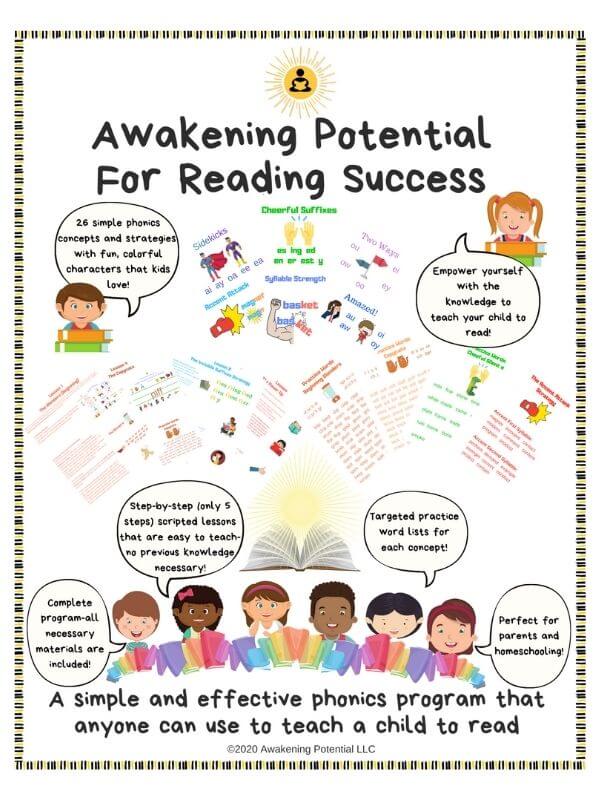Effective Online Dyslexia Tutoring Using
The Orton-Gillingham Approach
What Is Dyslexia?
Does your child struggle with basic reading skills, such as learning the sounds, reading words, and reading fluently?
Do they have average or above average intelligence, and yet still learn these skills very slowly?
If so, your child may have dyslexia. Although there is no single definition for dyslexia, it is generally defined as a learning disability in reading, or as having a strong challenge in learning the basic skills necessary for effective reading.
If your child has been diagnosed as having dyslexia, if you suspect they may have it, or if you just know that they are struggling with learning to read, then you are in the right place. Children who have dyslexia can be successful readers.
For 13 years I have been tutoring students with dyslexia, and I’ve seen them overcome their challenges and read effectively.


What Is Dyslexia?
Does your child struggle with basic reading skills, such as learning the sounds, reading words, and reading fluently?
Do they have average or above average intelligence, and yet still learn these skills very slowly?
If so, your child may have dyslexia. Although there is no single definition for dyslexia, it is generally defined as a learning disability in reading, or as having a strong challenge in learning the basic skills necessary for effective reading.
If your child has been diagnosed as having dyslexia, if you suspect they may have it, or if you just know that they are struggling with learning to read, then you are in the right place. Children who have dyslexia can be successful readers.
For 13 years I have been supporting students with dyslexia, and I’ve seen them overcome their challenges and read effectively.

What Help Should My Dyslexic Child Get?
Online dyslexia tutoring gives your child the exact support they need. With the right conditions, they can build their confidence and learn the essential skills and strategies needed to be an effective reader.
It is possible! Think of a giant redwood tree. The seed of this tree is very small, but it has the potential to become that huge natural wonder. All it needs is good soil, water, and clean air. With these conditions, it will definitely grow into what it was meant to become.
Children with dyslexia are exactly the same: They already have the potential to become great readers, writers, etc. All they need is the right conditions in order to thrive.
What Is The BEST Teaching Method For Dyslexia?
Here are the two most important methods for teaching a child with dyslexia:
- A teaching approach that is shown to be effective for students with dyslexia
- A patient tutor who can compassionately guide them through the learning process
With these conditions, a child with dyslexia can thrive as a reader!
What Does An Online Dyslexia Tutor Do?
- As your child’s dyslexia tutor, I’ll guide them to learning success with compassion and patience.
- I’ll see them for who they are (a whole person with the potential for enormous growth) and guide them toward what they can become (successful and confident learners).
- I will have patience with their mistakes, and help them to view their shortcomings (such as struggling with recognizing sounds to read words for example ) as temporary challenges that do not need to hold them back from becoming the best they can be.
- I will use the Orton-Gillingham approach for your child’s online dyslexia tutoring. This is an approach to learning that is very effective for kids with dyslexia. As your child’s dyslexia tutor, I’ll utilize this teaching approach in their lessons.
Let’s learn more about why this approach to learning is so effective, and why I use it at Awakening Potential.


What Does A Dyslexia Tutor Do?
- As your child’s Awakening Potential tutor, I’ll guide them to learning success with compassion and patience.
- I’ll see them for who they are (a whole person with the potential for enormous growth) and guide them toward what they can become (successful and confident learners).
- I will have patience with their mistakes, and help them to view their shortcomings (such as struggling with recognizing sounds to read words for example ) as temporary challenges that do not need to hold them back from becoming the best they can be.
So that fulfills the second condition. What about the first condition? The Orton-Gillingham approach is an approach to learning that is very effective for kids with dyslexia. As your child’s dyslexia tutor, I’ll utilize this teaching approach in their lessons.
Let’s learn more about why this approach to learning is so effective, and why I use it at Awakening Potential.
What Is The
Orton-Gillingham Reading Technique?

Orton-Gillingham is actually not a technique, but an approach to learning. It is a way of looking at the learning process, and it can be applied to teaching lessons for any subject. It includes these main elements:
- Structured lessons taught in a direct manner
- Systematic and sequential lessons
- Continuous review of previously learned material
- Use of multiple learning modalities
Any way of teaching that uses these elements, whether it be a single lesson or an entire program, is following the Orton-Gillingham approach. Let’s take a closer look at each of these elements and how they can be used in an online dyslexia tutoring reading lesson, using the Awakening Potential For Reading Success program as an example:
1. Structured lessons taught in a direct manner
The reading lessons should be structured, meaning that they follow a predictable sequence of steps in a particular order. For example, each reading lesson would include 6 steps, always taught in the same order.
In this example of “The Beginning Blenders” (Lesson 1) you can see that the 6 steps are:

Step 1: Read the previous Sounds

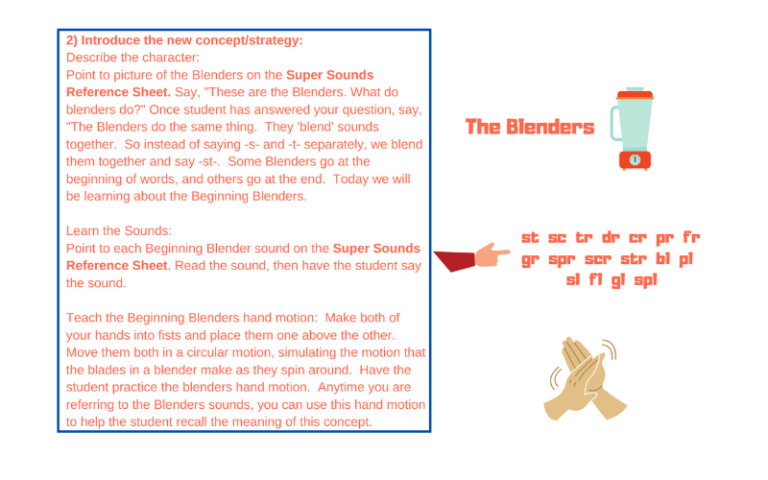
Step 2: Learn the New Concept/Strategy
Step 3: Practice on the Practice Board

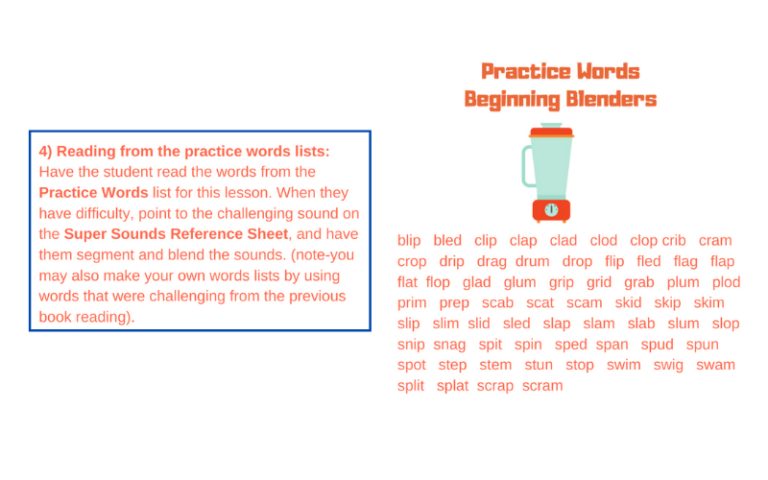
Step 4: Read the Practice Word List
Step 5: Play the Phonics Game
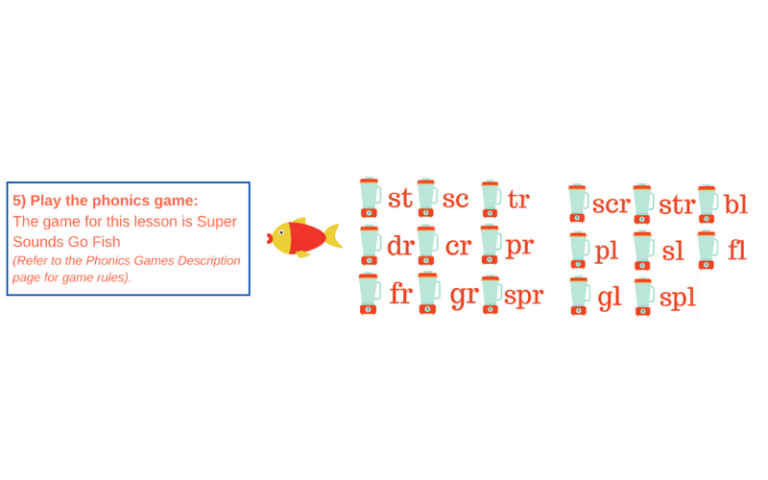

Step 6: Read the Book
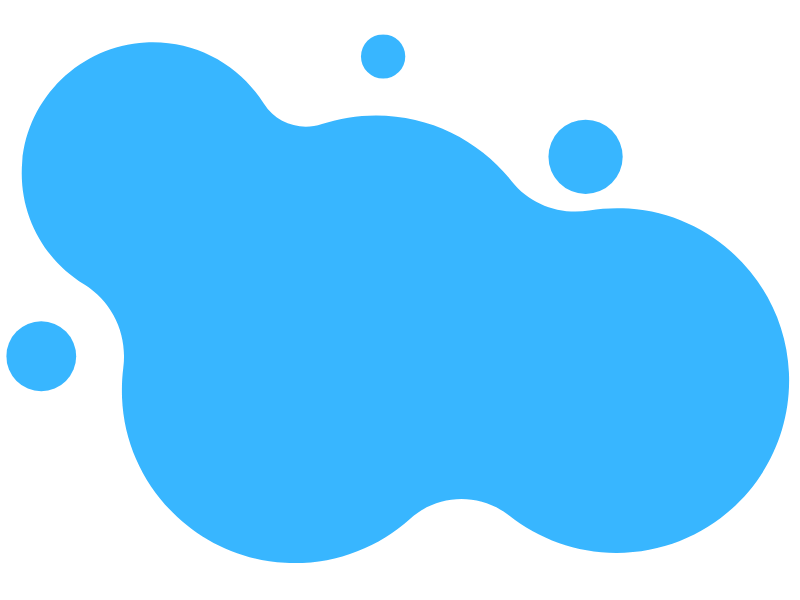
2. Systematic and sequential lessons
The next step of the Orton-Gillingham approach is to have lessons that systematically teach every essential concept or strategy, and that do so in a sequential manner.
This makes it easier for the student to learn, because they will gradually be building their skills bit by bit, and they won’t encounter any skills that are too hard for them until they are ready.
For example:
- Lesson 1 teaches the most basic concept (beginning consonant blends),
- Lesson 2 teaches the next level up concept (ending consonant blends).
- Lesson 3 teaches a concept the next level up from there (consonant diagraphs).
- And so on. Once they get to the final lesson (Lesson 32) they will have learned every reading concept and strategy they need, and they will have done so in a sequential order, building their confidence as they go.
3. Continuous review of previously learned material
The next essential element of the Orton-Gillingham approach is to continuously review material that has been learned previously.
This means that at the beginning of every lesson the child will review what they have learned from previous lessons, before learning any new material.
For example, in step 1, they will review all of the previous sounds they have already learned.
Reviewing previously learned material can also be done at other points in the lesson, such as when reading practice words from the practice word lists (step 4 in the Awakening Potential For Reading Success program). The student can review words from previous lists, and also read words from the new list. All of the required materials will be presented to the student during their online dyslexia tutoring session.


4. Use of multiple learning modalities
The last element of the Orton-Gillingham approach is to use multiple learning modalities in every lesson. This means that the child should use more than one of the senses in the learning process.
For example, if we take another look at Lesson 1 “The Beginning Blenders,” we’ll see that they will use their sense of sight when they see the new sound and the fun character that represents the sound, their hearing sense when they listen to the tutor explain the concept and say the sound, and their kinesthetic or body sense when they act out the ‘hand motion’ for that sound. By using these three learning modalities together, their learning will be greatly enhanced.
Now that we’ve seen how the Orton-Gillingham approach works and how it can be applied to reading, let’s see how this approach can be used for online dyslexia tutoring.
Looking For More Orton-Gillingham and Dyslexia Resources?
What Is The
Orton-Gillingham Reading Technique?

Orton-Gillingham is actually not a technique, but an approach to learning. It is a way of looking at the learning process, and it can be applied to teaching lessons for any subject. It includes these main elements:
- Structured lessons taught in a direct manner
- Systematic and sequential lessons
- Continuous review of previously learned material
- Use of multiple learning modalities
The last element of the Orton-Gillingham approach is to use multiple learning modalities in every lesson. This means that the child should use more than one of the senses in the learning process.
For example, if we take another look at Lesson 1 “The Beginning Blenders,” we’ll see that they will use their sense of sight when they see the new sound and the fun character that represents the sound, their hearing sense when they listen to the tutor explain the concept and say the sound, and their kinesthetic or body sense when they act out the ‘hand motion’ for that sound. By using these three learning modalities together, their learning will be greatly enhanced.
Now that we’ve seen how the Orton-Gillingham approach works and how it can be applied to reading, let’s see how this approach can be used for online dyslexia tutoring.
Any way of teaching that uses these elements, whether it be a single lesson or an entire program, is following the Orton-Gillingham approach. Let’s take a closer look at each of these elements and how it applies to teaching reading using the Awakening Potential For Reading Success program as an example:
1. Structured lessons taught in a direct manner
The reading lessons should be structured, meaning that they follow a predictable sequence of steps in a particular order. For example, each reading lesson would include 6 steps, always taught in the same order.
In this example of “The Beginning Blenders” (Lesson 1) you can see that the 6 steps are:

Step 1: Read the previous Sounds


Step 2: Learn the New Concept/Strategy
Step 3: Practice on the Practice Board


Step 4: Read the Practice Word List
Step 5: Play the Phonics Game


Step 6: Read the Book

2. Systematic and sequential lessons
The next step of the Orton-Gillingham approach is to have lessons that systematically teach every essential concept or strategy, and that do so in a sequential manner.
This makes it easier for the student to learn, because they will gradually be building their skills bit by bit, and they won’t encounter any skills that are too hard for them until they are ready.
For example:
- Lesson 1 teaches the most basic concept (beginning consonant blends),
- Lesson 2 teaches the next level up concept (ending consonant blends).
- Lesson 3 teaches a concept the next level up from there (consonant diagraphs).
- And so on. Once they get to the final lesson (Lesson 32) they will have learned every reading concept and strategy they need, and they will have done so in a sequential order, building their confidence as they go.
3. Continuous review of previously learned material
The next essential element of the Orton-Gillingham approach is to continuously review material that has been learned previously.
This means that at the beginning of every lesson the child will review what they have learned from previous lessons, before learning any new material.
For example, in step 1, they will review all of the previous sounds they have already learned.
Reviewing previously learned material can also be done at other points in the lesson, such as when reading practice words from the practice word lists (step 4 in the Awakening Potential For Reading Success program). The student can review words from previous lists, and also read words from the new list.


4. Use of multiple learning modalities
The last element of the Orton-Gillingham approach is to use multiple learning modalities in every lesson. This means that the child should use more than one of the senses in the learning process.
For example, if we take another look at Lesson 1 “The Beginning Blenders,” we’ll see that they will use their sense of sight when they see the new sound and the fun character that represents the sound, their hearing sense when they listen to the tutor explain the concept and say the sound, and their kinesthetic or body sense when they act out the ‘hand motion’ for that sound. By using these three learning modalities together, their learning will be greatly enhanced.
Now that we’ve seen how the Orton-Gillingham approach works and how it can be applied to reading, let’s see how this approach can be used for online dyslexia tutoring.
What Is The
Orton-Gillingham Reading Technique?

Orton-Gillingham is actually not a technique, but an approach to learning. It is a way of looking at the learning process, and it can be applied to teaching lessons for any subject. It includes these main elements:
- Structured lessons taught in a direct manner
- Systematic and sequential lessons
- Continuous review of previously learned material
- Use of multiple learning modalities
Any way of teaching that uses these elements, whether it be a single lesson or an entire program, is following the Orton-Gillingham approach. Let’s take a closer look at each of these elements and how it applies to teaching reading using the Awakening Potential For Reading Success program as an example:
1. Structured lessons taught in a direct manner

The reading lessons should be structured, meaning that they follow a predictable sequence of steps in a particular order. For example, each reading lesson would include 6 steps, always taught in the same order.
In this example of “The Beginning Blenders” (Lesson 1) you can see that the 6 steps are:
Step 1: Read the previous Sounds

Step 2: Learn the New Concept/Strategy

Step 3: Practice on the Practice Board

Step 4: Read the Practice Word List

Step 5: Play the Phonics Game

Step 6: Read the Book

2. Systematic and sequential lessons

The next step of the Orton-Gillingham approach is to have lessons that systematically teach every essential concept or strategy, and that do so in a sequential manner.
This makes it easier for the student to learn, because they will gradually be building their skills bit by bit, and they won’t encounter any skills that are too hard for them until they are ready.
For example:
- Lesson 1 teaches the most basic concept (beginning consonant blends),
- Lesson 2 teaches the next level up concept (ending consonant blends).
- Lesson 3 teaches a concept the next level up from there (consonant diagraphs).
- And so on. Once they get to the final lesson (Lesson 32) they will have learned every reading concept and strategy they need, and they will have done so in a sequential order, building their confidence as they go.
3. Continuous review of previously learned material

The next essential element of the Orton-Gillingham approach is to continuously review material that has been learned previously.
This means that at the beginning of every lesson the child will review what they have learned from previous lessons, before learning any new material.
For example, in step 1, they will review all of the previous sounds they have already learned.
Reviewing previously learned material can also be done at other points in the lesson, such as when reading practice words from the practice word lists (step 4 in the Awakening Potential For Reading Success program). The student can review words from previous lists, and also read words from the new list.
4. Use of multiple learning modalities

The last element of the Orton-Gillingham approach is to use multiple learning modalities in every lesson. This means that the child should use more than one of the senses in the learning process.
For example, if we take another look at Lesson 1 “The Beginning Blenders,” we’ll see that they will use their sense of sight when they see the new sound and the fun character that represents the sound, their hearing sense when they listen to the tutor explain the concept and say the sound, and their kinesthetic or body sense when they act out the ‘hand motion’ for that sound. By using these three learning modalities together, their learning will be greatly enhanced.
Now that we’ve seen how the Orton-Gillingham approach works and how it can be applied to reading, let’s see how this approach can be used for online dyslexia tutoring.
Can Orton-Gillingham Be Done Online?
Most definitely it can! I have been using the Orton-Gillingham approach in all of my online dyslexia tutoring sessions with students, and it works wonderfully.
All of the essential elements of the approach mentioned previously (structured lessons taught in a direct manner, systematic and sequential lessons, continuous review of previously learned material, and use of multiple learning modalities) can all be used in the online tutoring format, using the Zoom application.
When the online dyslexia tutor and the child meet for their session, all of the essential steps in each lesson will be followed in a structured way, directly teaching the concepts systematically and sequentially.

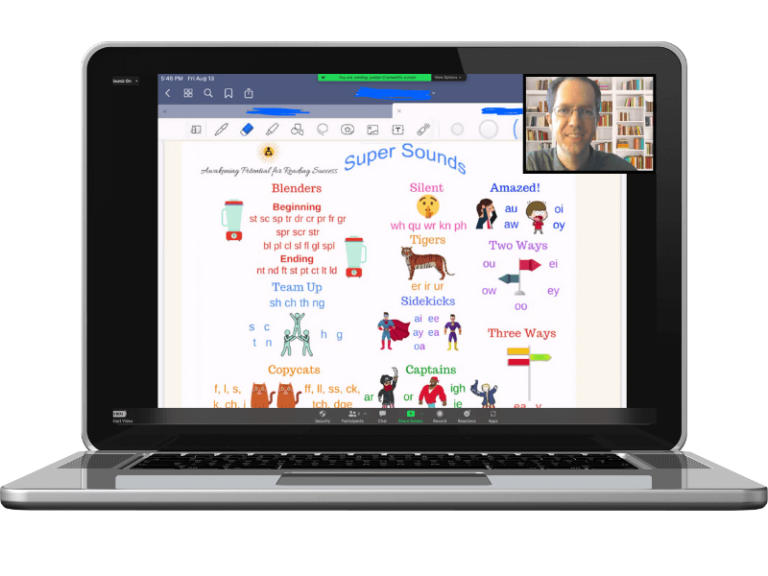
- The materials will be shared through screen sharing for the student to see on their screen during the lesson.
- They will be able to see the new sounds, review the old sounds, read from the practice word lists, read from the books, etc.
- They will also be able to use each of the learning modalities (seeing, hearing, and kinesthetic/movement) as they see the sounds on the screen, see the dyslexia tutor say the sounds, and practice the hand motions for each sound.
Can Orton-Gillingham Be Done Online?

Most definitely it can! I have been using the Orton-Gillingham approach in all of my online tutoring sessions with students, and it works wonderfully.
All of the essential elements of the approach mentioned previously (structured lessons taught in a direct manner, systematic and sequential lessons, continuous review of previously learned material, and use of multiple learning modalities) can all be used in the online tutoring format, using the Zoom application.
When the dyslexia tutor and the child meet for their online session, all of the essential steps in each lesson will be followed in a structured way, directly teaching the concepts systematically and sequentially.

- The materials will be shared through screen sharing for the student to see on their screen during the lesson.
- They will be able to see the new sounds, review the old sounds, read from the practice word lists, read from the books, etc.
- They will also be able to use each of the learning modalities (seeing, hearing, and kinesthetic/movement) as they see the sounds on the screen, see the dyslexia tutor say the sounds, and practice the hand motions for each sound.

About Me
Hello! My Name is Jordan Cromwell, and I am the Owner of Awakening Potential LLC, and an Awakening Potential Tutor. I have 14 years of experience tutoring students (including those with dyslexia and who are twice exceptional) to reach their full learning potential.
I do this by utilizing the Orton-Gillingham approach, which is effective for teaching all students, but in particular those with dyslexia and learning challenges. I also develop a long term relationship with my students, which greatly strengthens the learning process. My online tutoring sessions are both fun and effective! You can learn more about my qualifications by clicking here.

About Me
Hello! My Name is Jordan Cromwell, and I am the Owner of Awakening Potential LLC, and an Awakening Potential Tutor. I have 14 years of experience tutoring students (including those with dyslexia and who are twice exceptional) to reach their full learning potential.
I do this by utilizing the Orton-Gillingham approach, which is effective for teaching all students, but in particular those with dyslexia and learning challenges. I also develop a long term relationship with my students, which greatly strengthens the learning process. You can learn more about my qualifications by clicking here.
Ready For Online Dyslexia Tutoring Sessions?
and I will get in contact with you!

